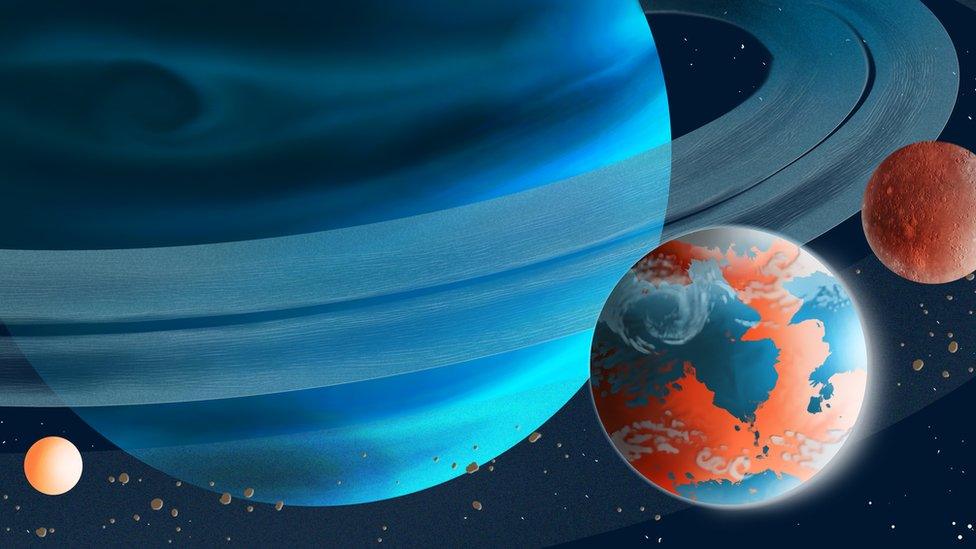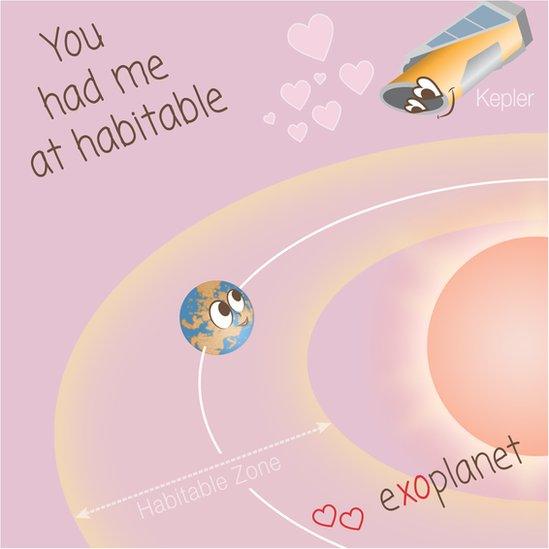Exomoons: On the hunt for distant worlds
- Published

Artist's impression: An exomoon orbits a distant planet
The search for exoplanets, which orbit distant stars, has opened up a whole galaxy of worlds beyond our own. Over 3,700 have been discovered to date, but they may have companions.
Since the first confirmed discovery of planets beyond our own Solar System over 20 years ago, we have known that our stellar neighbourhood is not unique in the Universe.
But now the frontier of exploration is shifting again; because where there are planets, there should be moons.
And those moons could be surprisingly Earth-like.
Why moons?
Thus far, scientists interested in potential habitable worlds beyond our Solar System have focused on planets that could resemble Earth; currently our only blueprint for life.
But what if these worlds don't orbit their star, but another planet instead?
A team of researchers at the University of Southern Queensland in Australia set out to explore this possibility; surveying the habitable zone of planetary systems observed by Nasa's Kepler telescope.
Also known as the Goldilocks zone, this is the region around a star where liquid water can exist at a planet's surface.

The team found, external that the predicted number of moons orbiting giant planets in these regions could well exceed that of rocky, Earth-like planets. This could make them the most abundant potential habitats for life.
"Considering the expected number of these moons in the habitable zone of their star, it is quite possible that the first signs of life found outside the Solar System, if it exists, could actually be found on a moon rather than an Earth-like planet," lead author Michelle Hill told BBC News.
So exomoons could well be some of the most important places in the Universe.
Signal may be from first 'exomoon'
But they are incredibly difficult to find. In fact, no one has confirmed a discovery yet.
"The habitable zone tends to be just at the very limit of our current detection methods," Dr Stephen Kane of UC Riverside, another author on the study, explains. Spotting planets there is tricky enough, but moons are another matter entirely.

Being in the habitable zone can drastically alter a planet's surface
Dr David Kipping, who leads a team at Columbia University, New York, has been interested in the idea of exomoons since he was a student.
"There aren't very many of us looking for these things, but I'm sure as soon as we start finding them there'll be more people who join in the hunt," he told the BBC.
"Trying to understand... how common [they are] will give us some sense of how unique the Solar System is."

How do moons form?
Most moons are thought to form from the leftover ingredients of their parent planet.
In our Solar System, Jupiter's large family of moons likely formed from the accumulation of this material when the planet was young.
Moons can also start out as dwarf planets or asteroids orbiting their star, only later to be captured by planets with a much stronger gravitational pull.
This is thought to be the case for Triton, which orbits backwards around its host planet Neptune, and may previously have lived in the Kuiper Belt - a distant zone of the Solar System beyond Neptune's orbit.

Our own Moon formed via a giant impact. When another large body collided with the early Earth, the resulting debris collected to create the Moon.
The Earth and Moon actually make for an unusual couple within our own Solar System.
"It's a giant moon basically, compared to the Earth. And it's not really obvious whether that's a rule of thumb or it's extremely unusual within the universe," explains Dr Kipping.

What makes a moon a good home?
Well, size matters.
"You could certainly have a giant planet that had moons which were similar in size and mass to, say, Mars, and so that would create far more habitable conditions," says Dr Kane.
An atmosphere can also radically increase a planet's ability to host life, and bodies need to reach a certain size in order to retain one.
"One of the major impacts on the ability of planet to retain its atmosphere is how far away it is from the [star], because the [star] emits what we call a solar wind, which tends to erode an atmosphere," he added.
A planet's magnetic field can protect its moon from the harsh solar wind.

Jupiter pulls and stretches tiny Io, causing the heat which fuels its volcanoes
In addition to water, life also needs energy, which can be provided by the gravitational pull of a planet squeezing at a moon - as it does with highly volcanic Io.
So when are we likely to find the first exomoon?
Dr Kipping's team have identified exoplanet Kepler 1625b as a potential candidate for hosting an exomoon, but they have not yet been able to confirm a discovery.
A Jupiter-sized planet, it sits about as far from its star as the Earth is from the Sun.

Artist's impression: Exoplanet Kepler 1625b may host a moon
But finding life isn't easy
However, finding even hints of life on an exomoon will be extremely difficult.
"In the Solar System we have no idea whether [icy moons] have life underneath the surface or not. And it's very, very difficult even when we live next door to those objects to make any assessment of what's going on beneath the surface of the ice... Imagine doing that from light-years away," says Dr Kipping.
Despite the challenges, Prof Giovanna Tinetti, an exoplanet researcher at University College London, believes that it's best to keep an open mind.
"I think we need to be open when it comes to habitability, [and] certainly not stay attached to the... view that you need to have a planet that's big like the Earth, the same distance from the Sun with a star that's exactly like the Sun.
"I would hope life is a little bit more original than that."
Follow Mary on Twitter, external.